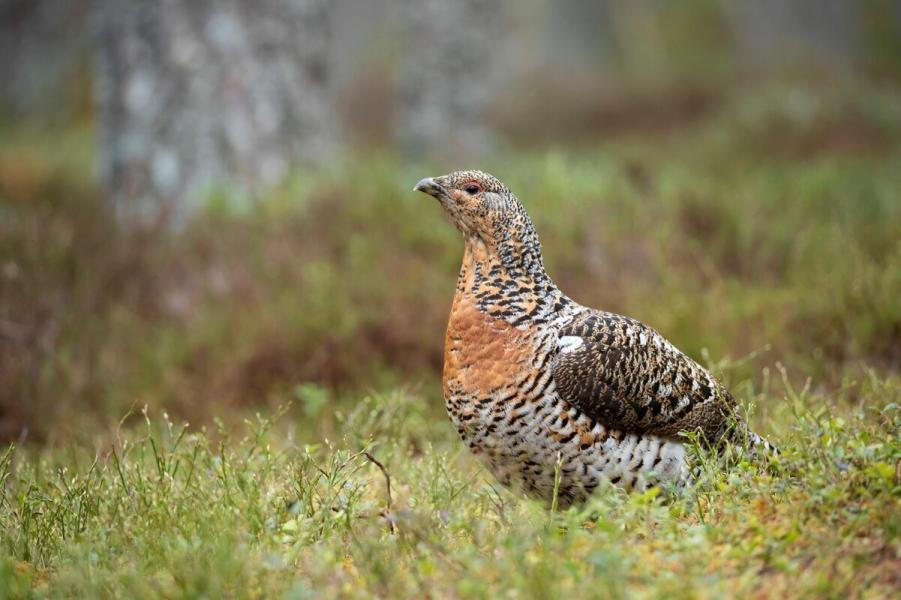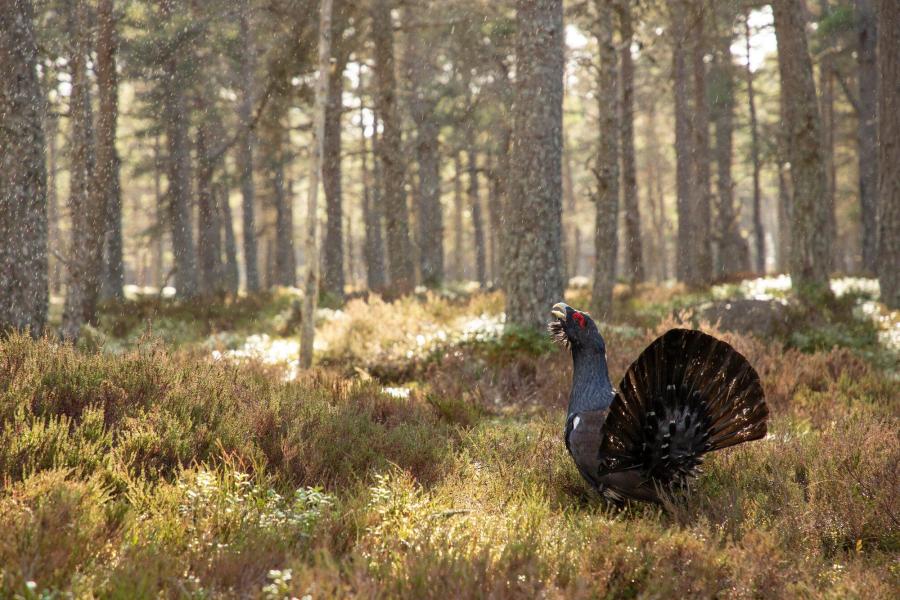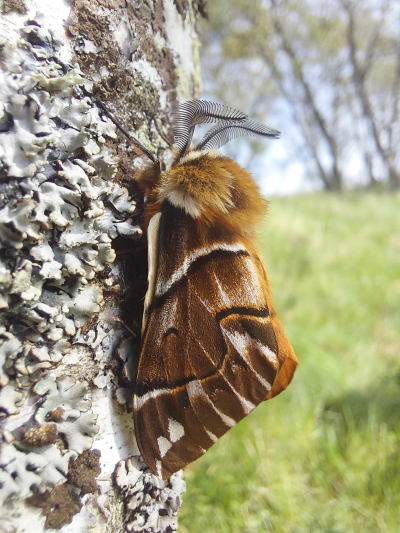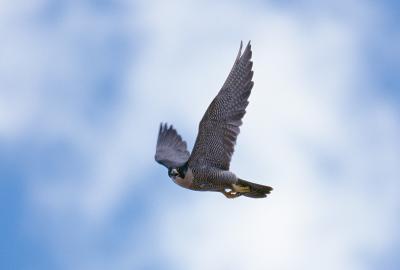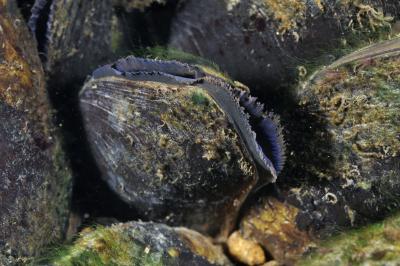Capercaillie
Tetrao urogallus

Known in Gaelic as the horse of the woods, this name - most likely inspired by the males of the species - provides a clue to the capercaillie’s impressive bulk. Male capercaillie can hold huge territories in their preferred Caledonian pine forest habitat.
Factsheet
Weight: 1.5 to 5kg
Lifespan: Up to six years
Best time to spot: Best time to spot: Never look for capercaillie. It is a criminal offence to disturb the birds when they are breeding and winter is a demanding season. It is better for the birds’ survival to leave them in peace all year round.
Nature spotters often mistake black grouse for capercaillie, but the latter is much larger and makes its home in woodland. The smaller black grouse, on the other hand, selects open ground at the edge of forests.
Male capercaillie have dark, almost black, feathers with a metallic green sheen on their throat and breast. Their wings are brownish with white spots, and they have a fan-shaped tail that has black and white barring. A thick red wattle (area of bare skin) and short, hooked yellow bill add to this bird’s distinctiveness.
Female capercaillie are much smaller than the male and are mottled brown, grey and black, which provides good camouflage in their forest habitat. Their tail is not as large or striking as the male’s, and it is more rounded.
Each spring, male capercaillies attend lek sites which have been used for generations. There they perform a display of whistles and flutter jumps to attract the attention of females.
If successful at the lek, females will lay around eight eggs in May in a nest on the forest floor. They visit forest bogs to feed on protein-rich cotton grass to stay strong and healthy whilst breeding.
Did you know?
Known in Gaelic as the horse of the woods, this name - most likely inspired by the males of the species - provides a clue to the capercaillie’s impressive bulk. Male capercaillie can hold huge territories in their preferred Caledonian pine forest habitat.
Factsheet
Weight: 1.5 to 5kg
Lifespan: Up to six years
Best time to spot: Best time to spot: Never look for capercaillie. It is a criminal offence to disturb the birds when they are breeding and winter is a demanding season. It is better for the birds’ survival to leave them in peace all year round.
Nature spotters often mistake black grouse for capercaillie, but the latter is much larger and makes its home in woodland. The smaller black grouse, on the other hand, selects open ground at the edge of forests.
Male capercaillie have dark, almost black, feathers with a metallic green sheen on their throat and breast. Their wings are brownish with white spots, and they have a fan-shaped tail that has black and white barring. A thick red wattle (area of bare skin) and short, hooked yellow bill add to this bird’s distinctiveness.
Female capercaillie are much smaller than the male and are mottled brown, grey and black, which provides good camouflage in their forest habitat. Their tail is not as large or striking as the male’s, and it is more rounded.
Each spring, male capercaillies attend lek sites which have been used for generations. There they perform a display of whistles and flutter jumps to attract the attention of females.
If successful at the lek, females will lay around eight eggs in May in a nest on the forest floor. They visit forest bogs to feed on protein-rich cotton grass to stay strong and healthy whilst breeding.
Did you know?
Capercaillie chicks hatch from late May and feed on insects they find in the ground vegetation. If we experience a wet spring, insects can be in short supply. This can lead chicks to starve. Others may die of cold or be eaten by predators. Typically, only one chick per brood will make it to adulthood.
Making it off the forest floor and into the branches is a big step towards relative safety for chicks, who are able to fly within two to three weeks of hatching.
By September, young birds are independent of their mother. They disperse from where they were born, with females often travelling further than males - up to 30km from their birthplace if the right habitat is available.
The Cairngorms National Park is the capercaillie’s last stronghold in the UK. A specialist species, it is only able to survive in a narrow range of conditions. Capercaillie require extensive areas of Scots pine-dominated woodland, which is only available in Scotland, and a varied forest structure, including open areas to feed and dense areas for cover. Adult birds eat conifer shoots and buds in the winter and blaeberry leaves and berries in spring and summer.
These specific habitat needs make capercaillie particularly vulnerable. Widespread destruction of Caledonian pine forests combined with hunting in the 18th century led to capercaillie becoming extinct in Scotland. They were reintroduced during the 19th century from Scandinavian stock, and their population increased steadily. But since the 1970s, their numbers have been back in decline.
Capercaillie continue to face threats, including habitat loss, predation, climate change and human disturbance.
Need to know
Capercaillie are a Schedule 1 species, protected under UK law, and it is a criminal offence to disturb these birds when they are breeding.
To help prevent disturbance to capercaillie we ask that you:
- Avoid capercaillie sensitive areas from April 1 to August 31 or stick to the main paths, stay quiet and avoid stopping.
- Don't visit lek sites during April and May when capercaillie are mating.
- If you encounter a capercaillie, stay still, quiet, and let them move off naturally. Don’t follow them.
- To protect sensitive sites, don't share capercaillie images or location details online.
- In winter, capercaillie are working hard to conserve energy. Consider leaving them undisturbed.
- If capercaillie show unusual behaviour or appear tame, withdraw immediately. Don’t photograph, film, or share its location and report sightings to [email protected]






